MusicRadar Verdict
Circuit Rhythm is a little harder to love than its Tracks counterpart, but it’s well-made and very powerful for the price, nonetheless.
Pros
- +
Features all the excellent sequencing tools of Circuit.
- +
And with expanded sampling capabilities.
- +
Grid FX are a lot of fun and useful for live performance.
- +
Portable, lightweight and well built.
Cons
- -
Occasionally feels like you’re wrestling with the lack of
- -
a screen.
- -
Sampling is monophonic, despite stereo I/O.
MusicRadar's got your back
What is it?
Regular readers will know our fondness for Novation Circuit. The British brand’s fun, intuitive little groovebox packs a shocking amount of potential into its diminutive frame, with the inclusion of two polysynths, a four-track sample sequencer and – as of the recent Circuit Tracks update – multiple channels of external sequencing.
Now Novation is further expanding the Circuit range with Circuit Rhythm, a new counterpart that ditches the original’s multi-functional ethos in favour of a focus purely on sampled grooves.
Hardware-wise, aside from a lighter coloured top panel and some slight variations in how controls are labelled, there’s very little to distinguish Tracks and Rhythm. This latest instrument is housed in the exact same chassis as its sibling, which is once again thin and fairly lightweight without feeling flimsy. The interface layout is also identical – keeping the 8x4 bank of pads that handle sequencing, flanked by navigational and transport buttons, with a bank of eight macro parameter rotaries along the top.
An identical internal battery sits inside, offering around four hours of battery life. Even the rear panel I/O is the same as Circuit Tracks, with a stereo pair audio output, stereo input pair, MIDI in, out and thru, analogue clock output, microSD card slot and a USB port for both power and connection to a computer. Despite the visual similarities though, in use, there’s a lot that’s fresh about Circuit Rhythm.
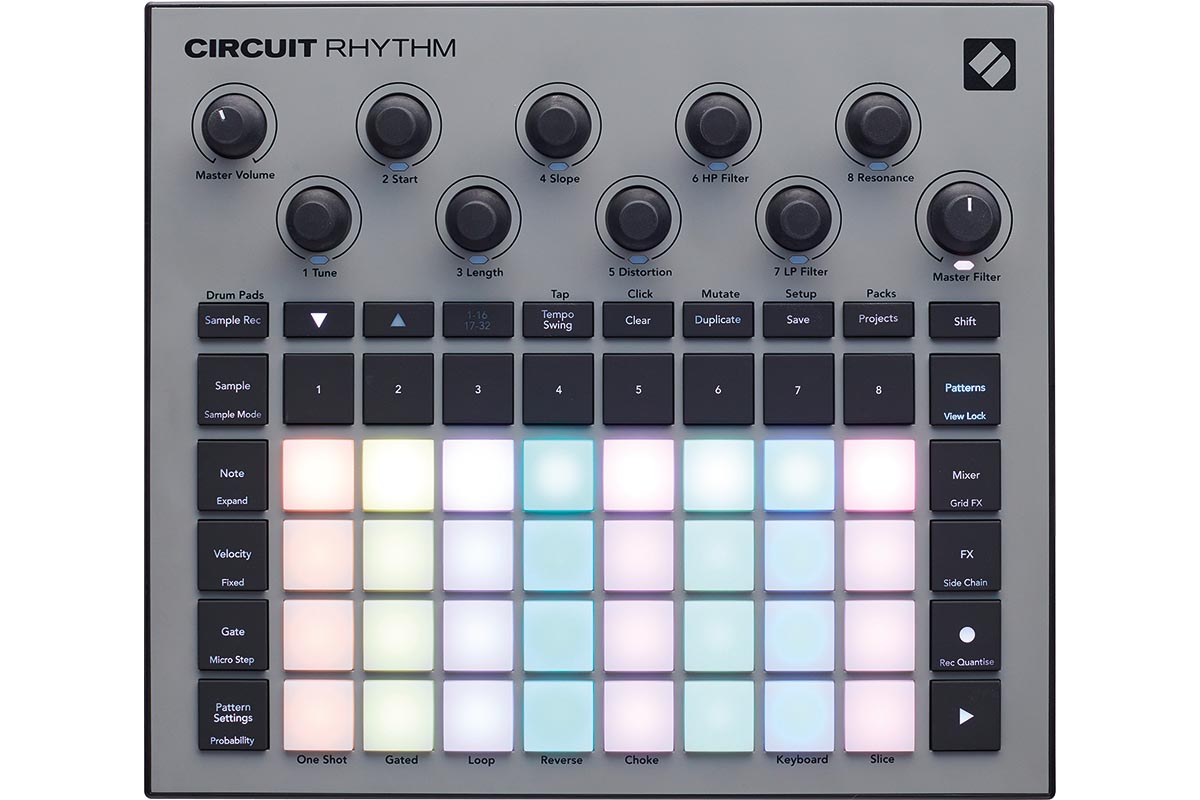
Performance and verdict
In all honesty, the sample section of Circuit Tracks is probably the weakest of its core elements – it works nicely in conjunction with the sequencer, but the editing of samples is fairly limited and, personally, it’s the element of both the original Circuit and Circuit Tracks we’ve found ourselves using least. Fortunately, Novation has considerably upped the capabilities here, making the workflow more in line with what you could call a genuine ‘sampler’ rather than a rudimentary sample player.
Crucially, you can actually sample into Circuit Rhythm, either by recording through the rear inputs or by directly resampling the sound engine. There’s an increased number of tracks available too, doubling Circuit Tracks’ four sample channels to eight. There are expanded sample playback modes too, with the default One Shot mode joined by Gated playback and Looping, plus a sample slice function.
Circuit Rhythm has a fairly generous onboard memory. There are a total of 128 sample slots split across eight menu pages, each of which can house a sample of up to 32 seconds in length. All samples are summed to mono, which is a bit of a shame seeing as the hardware has stereo inputs and outputs, but not really surprising at this price point.
By default, the sample slots come filled with sounds from Novation’s factory sound pack, which offers a broad if, perhaps understandably, fairly generic array of percussion sounds, FX, melodic loops, and the like. It’s a simple job to clear any sample you’re not enamoured with though, freeing up the slot for a new recording.
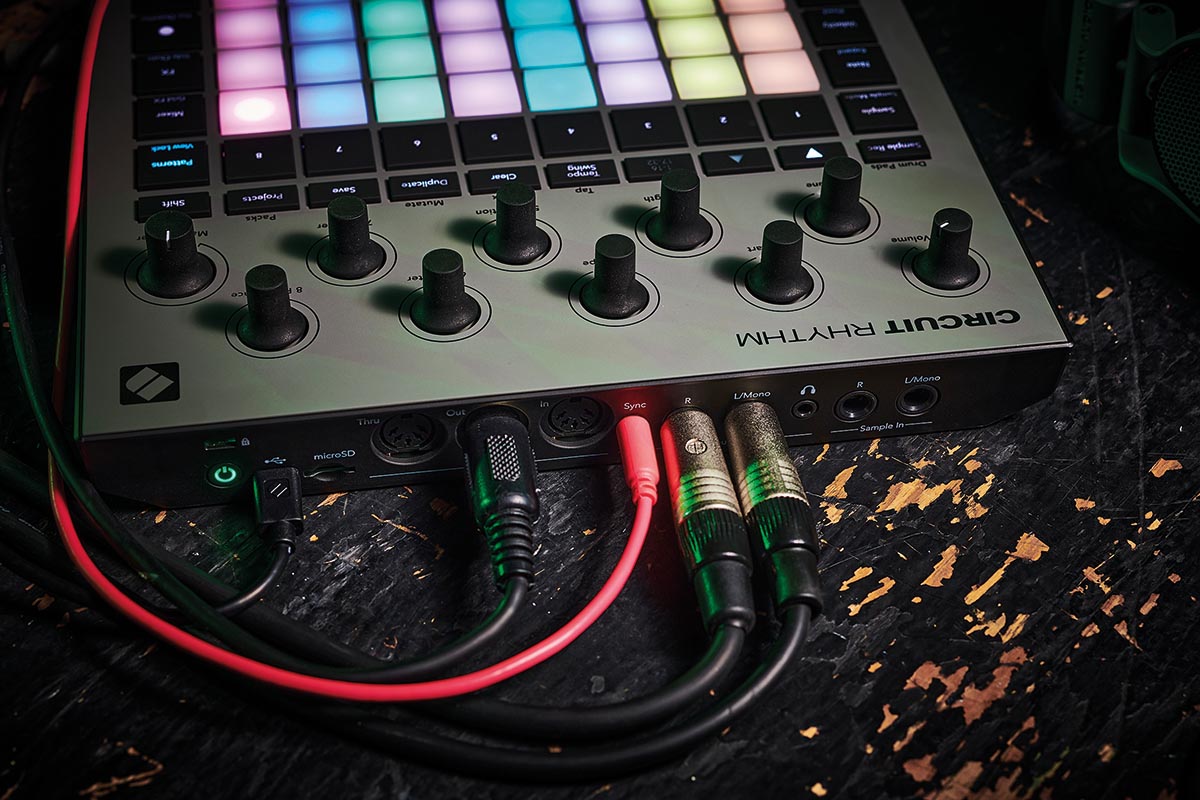
The process of recording and editing samples is generally well implemented although it does feel somewhat hindered by the lack of a screen. I’ve always thought the original Circuit and Circuit Tracks managed to get away without the inclusion of a screen, even as the complexity ramped up with various firmware feature additions. In fact, you could argue that those grooveboxes are improved by avoiding any sort of menu diving.
When it comes to capturing and editing samples though, you do end up feeling like you’re having to work around the lack of visualisation. That’s not to say it’s too hard or cumbersome sampling into Circuit Rhythm but, for example, trimming the start and end points or a recorded sample by ear is always going to be less convenient than doing so on a visualised waveform.
On that point, there’s fortunately a Threshold setting to automatically trigger sampling once an audio input is detected, which thankfully reduces the need to trim sample start points. Input level monitoring is another area that would benefit from a screen though. Circuit Rhythm normalises samples, and has an attenuator that can be switched on to tame particularly hot audio sources.
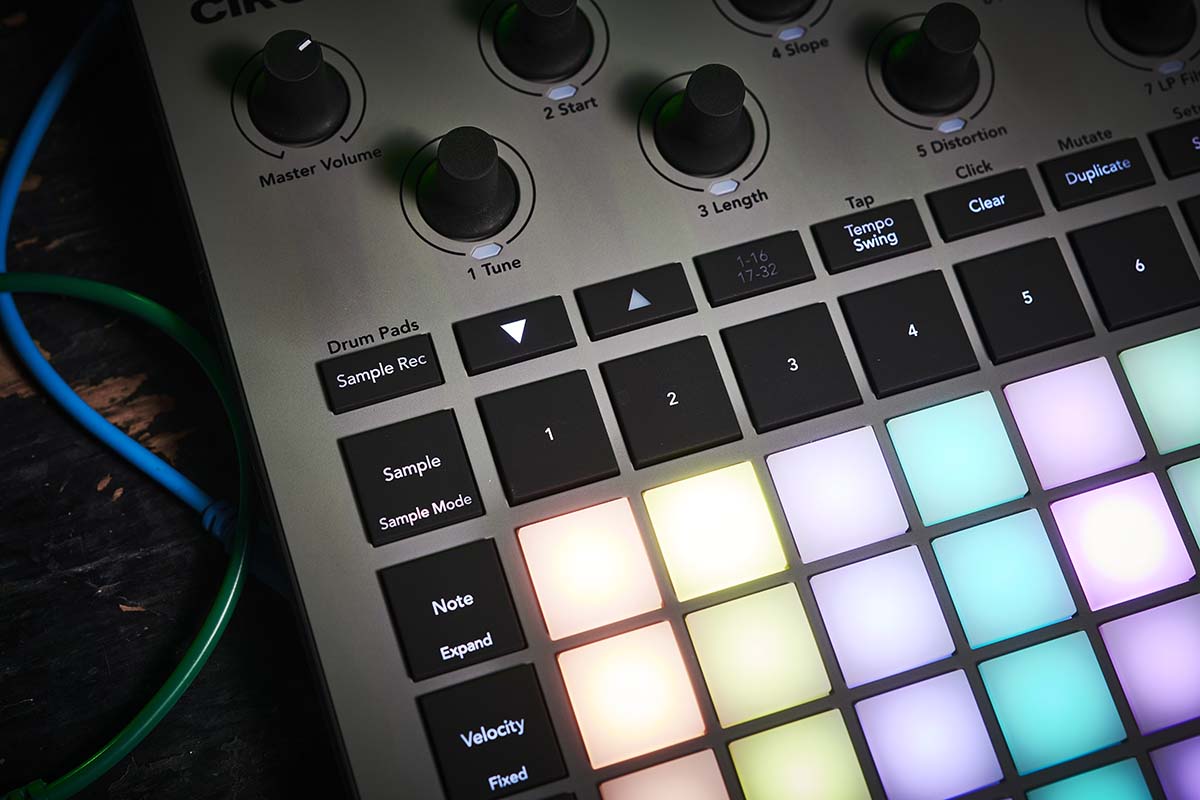
While you can, of course, get an idea of levels by monitoring the input through headphones or speakers, there’s still a certain amount of trial and error to avoid either distorted recordings at one extreme or an overly boosted noise floor at the other – which would be simpler to avoid with a visual input monitor.
Compounding this issue slightly is the general increase in complexity compared to Circuit Tracks. Due to adding sampling into the mix, the central pad grid now frequently ends up doubling up as a tool for adjusting settings. Some functions, such as sample playback mode, are labelled on the hardware while others – in some cases assigned to the same pad – aren’t.
Circuit Rhythm’s workflow keeps much of what makes its sibling instruments so fun
For instance, the pad that engages choke groups has a ‘Choke’ label beneath it, but in a different view, this same pad is used to engage/disengage record monitoring, a function that isn’t labelled on the hardware. It can end up being a little confusing to navigate and, at least at first, we’d recommend keeping a manual handy.
These minor gripes aside, Circuit Rhythm’s overall workflow maintains much of what makes its sibling instruments so fun. Samples can be sequenced in several ways, the first being Sample view, which matches the sample workflow of Circuit Tracks – with a sequencer laid out across the top two rows of pads, and a bank of samples across the lower two.
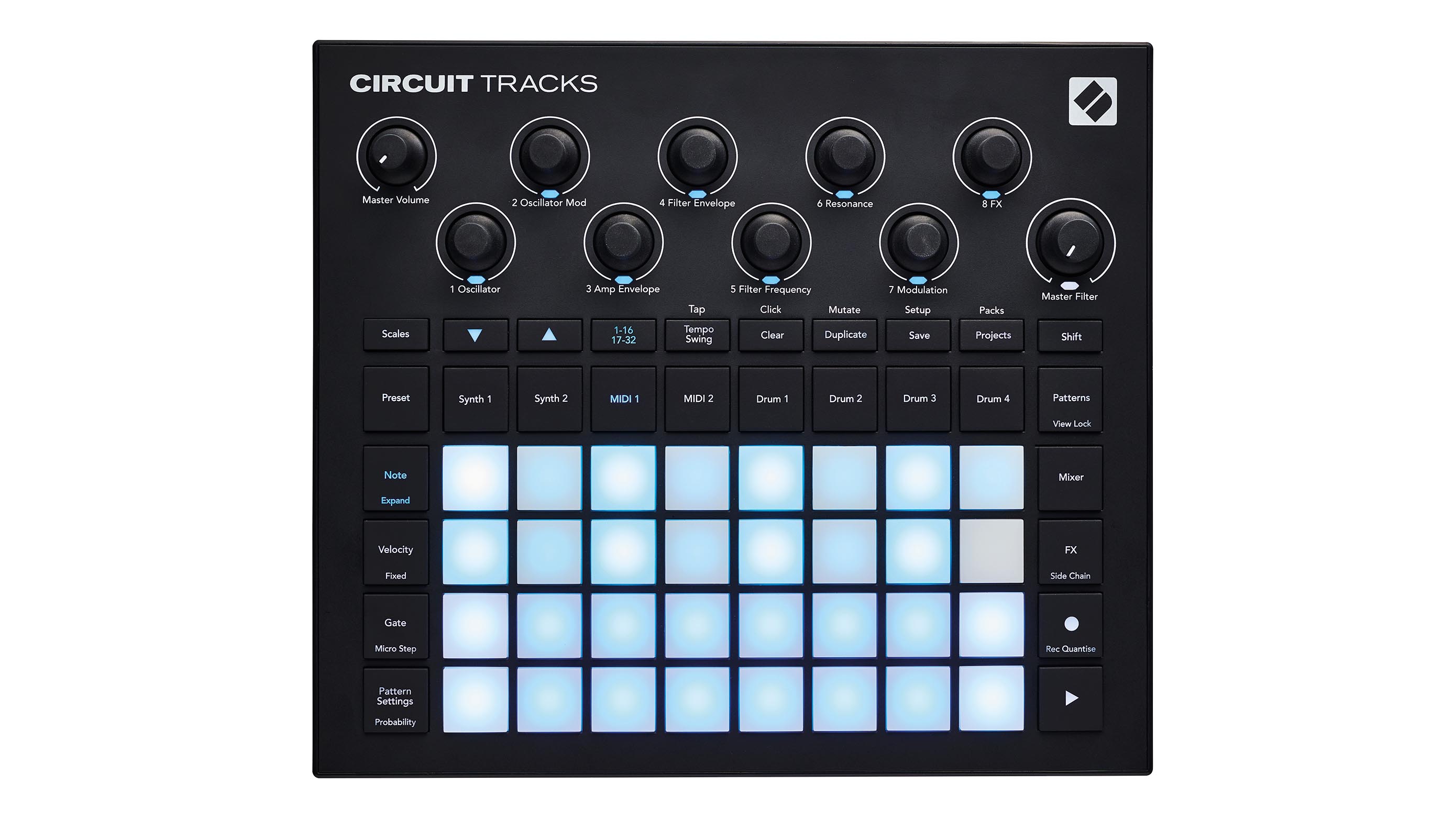
• Novation Circuit Tracks
The sampling capabilities of Tracks are far shallower than Rhythm, but the powerful polysynths and external sequencing tracks make this a killer all-rounder for studio or stage.
• Elektron Digitakt
Elektron’s compact sampler is a step up in price range, but its sample engines are more powerful and the inclusion of a screen allows for deeper editing.
• Korg Electribe Sampler
Probably the closest thing Rhythm has to a direct rival. The Electribe Sampler is a few years old now. It’s screen does help navigation, and the sample engines are more powerful, but overall the Rhythm’s workflow is slicker.
As with Tracks, this allows users to program sample flips, whereby each sequencer step can have its own sample assigned – a handy way to increase the scope beyond the eight-track polyphony.
Below the Sample view is Note mode. Here samples can be played and sequenced in one of two different ways. The first is melodically, where samples can be played chromatically across the pads (although unfortunately there are no scales included here, as there are on Circuit Tracks).
A secondary mode here lets the user slice a loop into 16 evenly spaced segments, which can be triggered and sequenced independently. For situations where automatic slicing doesn’t work, Rhythm includes a manual slicing function, which involves adding slices ‘live’ by ear – again, this would be easier with a screen, but the existing implementation is solid enough to suffice.
The amount of editing control from the Macros is increased here too. There are now eight sample parameters to adjust: pitch, start, end, slope (which alters the shape of the amp envelope), distortion (which sounds great), high-pass filter cutoff, low-pass filter cutoff and low-pass resonance. As with previous Circuits, it’s possible to record automation of these into patterns. There’s also a reverse mode for samples, accessed in the sampling/edit view.
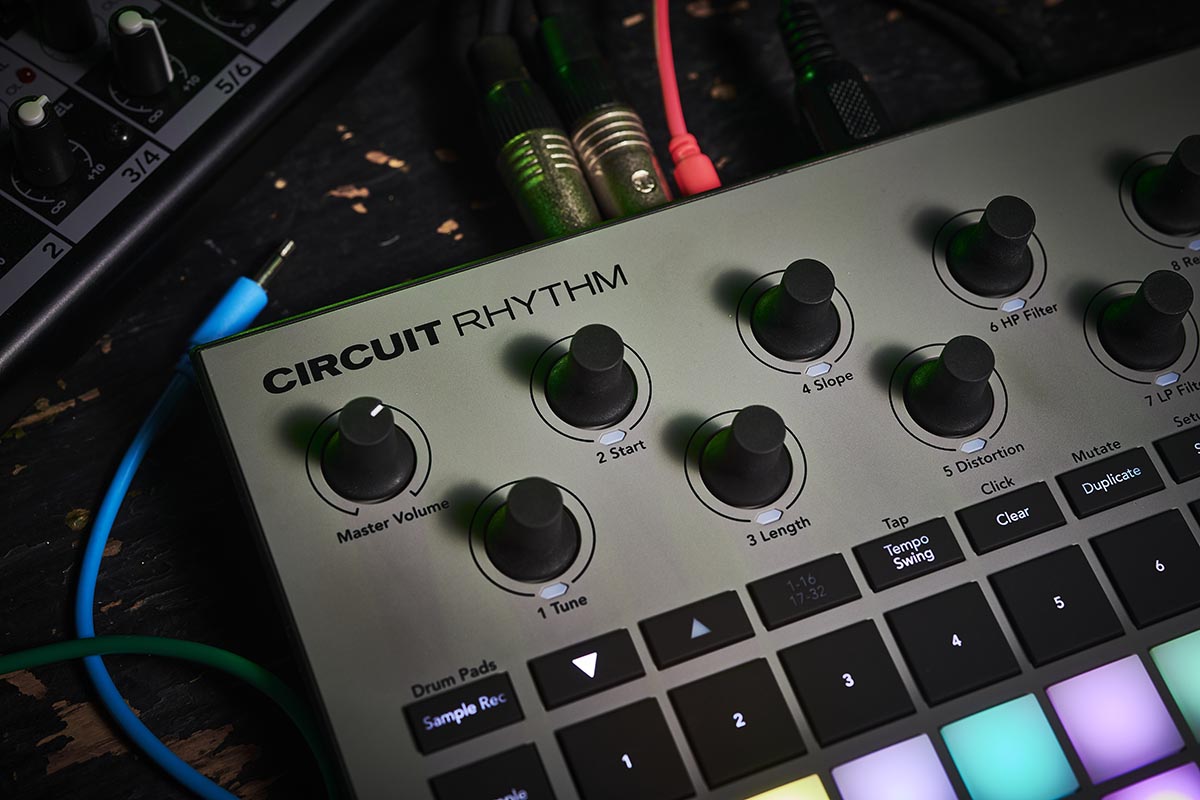
Broadly speaking, most of the remaining features match the workflow of Circuit Tracks. Sequencing, as before, is intuitive and fun, albeit with some deeper tools available including flexible pattern chaining, micro timings, probability sequencing and the excellent Mutate tool, which can ‘shuffle’ your patterns to create new ideas. The effects offering from Circuit Tracks is carried over here too, offering preset-based delay and reverb, sidechain ducking and a global DJ-style filter, all of which can be applied to external audio as well as the internal engine.
The one other significant new element added here is the Grid FX. This is a bank of punch-in effects accessed in the mixer section, which apply performance effects across the master output such as beat repeats, rhythmic gating, phasing and a vinyl emulation effect. These are also applied to external audio, making Rhythm a potentially handy processor for live users. These can also be triggered via MIDI, which is a neat touch.
They’re particularly fun for manipulating and resampling sounds into new sample slots. The only slight disappointment is that there’s no option to apply Grid FX to just selected tracks, or route some tracks around the effects – it’s an all-or-nothing deal.
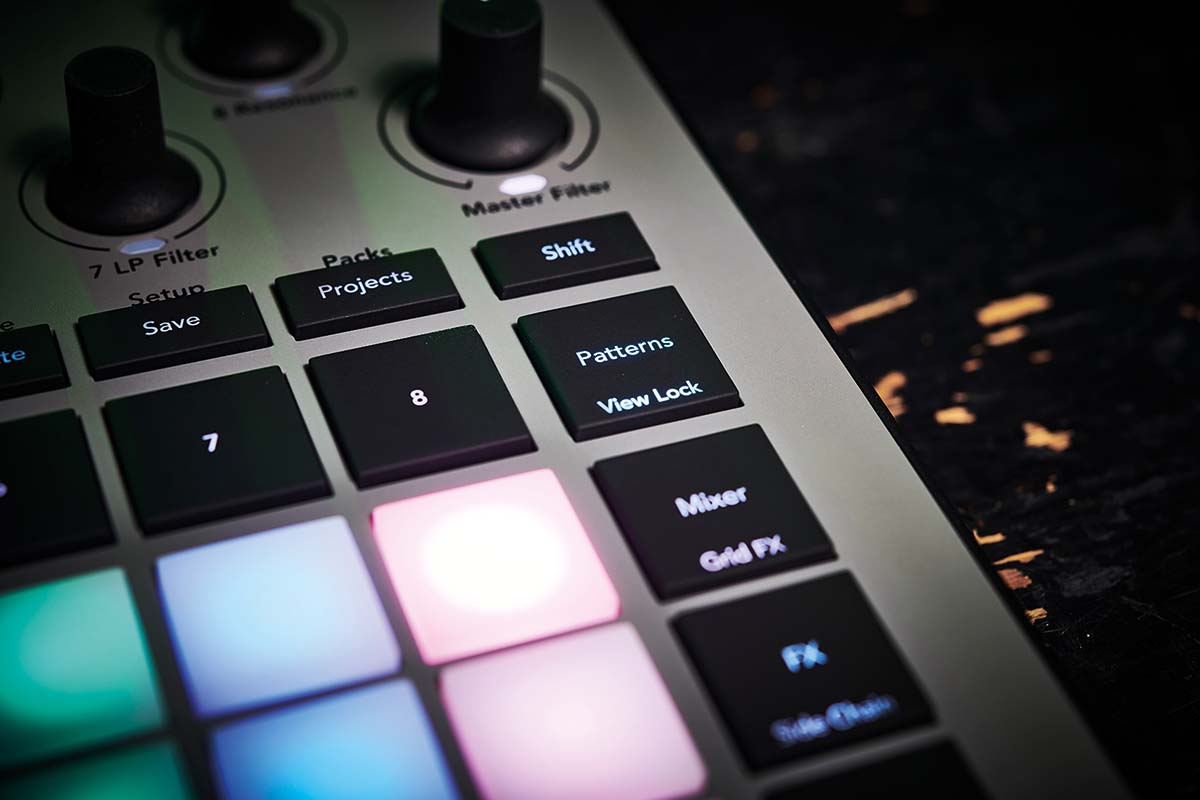
Finally, it’s worth noting that while Circuit Rhythm doesn’t shout about its MIDI sequencing capabilities like Tracks, it still outputs MIDI from each of its sequencer tracks, as well as CCs from the macro knobs, meaning it’s got plenty of potential as a MIDI sequencer in its own right.
There’s a lot to like about Circuit Rhythm in all, although it doesn’t feel like quite the unqualified success that Circuit Tracks is. Sampling is inherently more complicated than the mostly preset-focused operation of Circuit Tracks, and for reasons already discussed, the result is that Circuit Rhythm lacks a little of the intuitiveness of its predecessor. Unlike with Tracks, it’s hard not to feel that the addition of a small screen would improve things here.
All that said, it remains fun and creatively powerful. At this price, Circuit Rhythm slots into a sensible spot in the market too – a notch down from Elektron’s Digitakt in both price and capabilities, but a big step up from the Volca Sample. The MIDI capabilities, ability to act as an external effect processor and handy tools offered by Components add up to a good value package too. A worthy addition to the Circuit range, even if perhaps destined to be overshadowed by Tracks in the long run.
MusicRadar verdict: Circuit Rhythm is a little harder to love than its Tracks counterpart, but it’s well-made and very powerful for the price, nonetheless.
Hands-on demos

Specifications
- KEY FEATURES: Eight-track hardware sampler with one-shot, gated and loop sample modes. Feature reverb, delay, sidechain, bi-directional filter and master compressor effects, plus 16 punch-in Grid FX.
- I/O: Stereo pair of 1/4” jack inputs, stereo pair of 1/4” jack outputs, headphone out, MIDI in, out and thru (also usable as a second MIDI out), USB, analogue clock out, microSD port
- CONTACT: Novation
I'm the Managing Editor of Music Technology at MusicRadar and former Editor-in-Chief of Future Music, Computer Music and Electronic Musician. I've been messing around with music tech in various forms for over two decades. I've also spent the last 10 years forgetting how to play guitar. Find me in the chillout room at raves complaining that it's past my bedtime.
With its latest free update, Ableton has finally turned Note into the app I always wanted it to be
Technically capable, but struggle to make your tunes sound musical? 5 simple music theory hacks to make your tracks stand out
"Despite its size, it delivers impressive audio quality and premium functions as well as featuring a good selection of inspired sounds": Roland GO:Piano 88PX review










